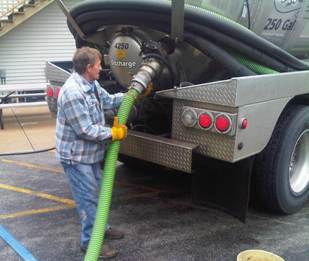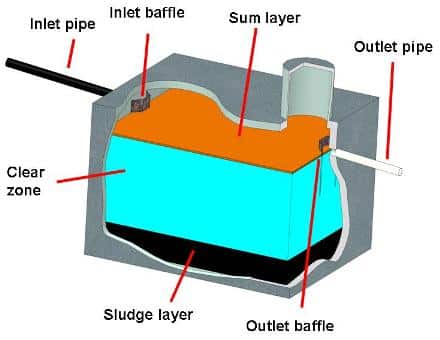How frequently should your septic tank be pumped?
 Ask this question of a dozen people and you’ll get a dozen answers ranging from:
Ask this question of a dozen people and you’ll get a dozen answers ranging from:
- “2 times a year”
- “never
- I haven’t pumped mine in 30 years
- “gee, I don’t know”.
The correct answer is when it needs it! Bear with me a minute so I can explain.
The typical septic tank needs pumping every 3 – 5 years. If you pump your tank too often you are wasting your money AND stressing your system. Pumping not frequently enough will lead to premature failure of your drainfield.
From a functional standpoint, the septic tank should be pumped when the accumulated solids (or sludge) and scum layer reach approximately 30% of the septic tank volume. Your septic tank is sized relative to the daily estimated flow rate of wastewater coming from the dwelling.
 Most codes base the estimated flow rate on the number of bedrooms in the dwelling. The calculation is:
Most codes base the estimated flow rate on the number of bedrooms in the dwelling. The calculation is:
2 people per bedroom X 75 gallons per person = the daily flow rate.
For example: 3 bedrooms X 2 people per bedroom X 75 gallons per person = 450 gallons per day. In this case, the minimum tank size would be 900 gallons. This will allow the wastewater to be held in the septic tank for 2 days (48 hours) to allow adequate decomposition of the organic material before the wastewater flows out to the drainfield.
Why is it recommended to pump your tank at 30% of the septic tank volume rather than 70% or 90%? The reason is that as the solids and scum layer begin to accumulate in the septic tank, the hold time is reduced. As the hold time is reduced, the amount of decomposition of the organic material is reduced. This results in poorly treated wastewater flowing to the drainfield resulting in premature failure of the drainfield.
Using the example above, if the septic tank is 30% full of solids and scum, the hold time is reduced by approximately 15 hours. If the septic tank is 90% full of solids and scum the hold time is reduced to only 5 hours. In the latter case, raw sewage will be flowing to the drainfield and you will be sure to have significant problems!
Every septic tank will build the solids and scum layer at different rates. Depending on how many people live in the home, the occupants diet make-up, water use habits, system abuse, etc. The rate of the accumulation of solids and scum in the septic tank cannot be estimated. The best practice to determine when the tank needs to be pumped is to measure the accumulated solids with a device called a sludge judge.
An alternative method to predict when the septic tank needs pumping is to keep pumping records. Each time the tank is pumped, demand that the pumper provide the amount of accumulated solids in the bottom of the tank, measured in inches, the thickness of the scum layer at the top layer in the tank, measured in inches, AND the liquid depth of the tank.
A quick calculation to determine the percentage is as follows: 8” of solids + 3” of scum / 42” of liquid depth = 0.26 or 26% of accumulated solids/scum in the tank. The tank was last pumped 24 months ago. To determine the pumping frequency, divide the pumping interval by the percent of accumulation and multiply by 30% (0.30). This will give you the correct pumping frequency in months. Using the example above: 24 months / 0.26 X 0.30 = 27.69 or 27 months. Each time the septic tank is pumped, perform this quick calculation and record it. As you collect more data, adjust the pumping frequency to obtain the 30% rule!
To learn how to measure the accumulated sludge look, for a follow-up post entitled “How to Measure Septic Tank Sludge Depth”.











